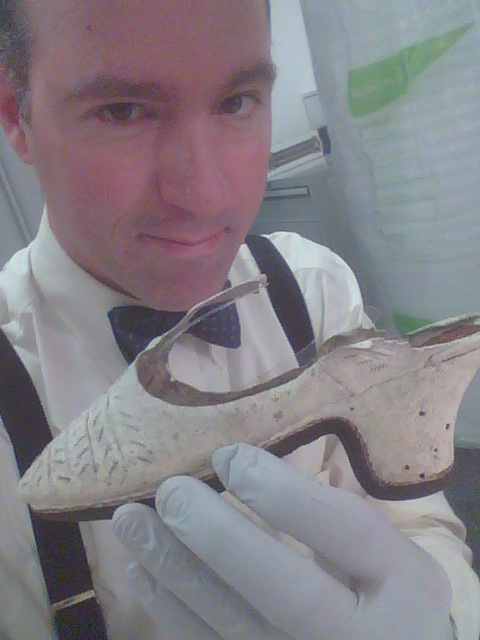I’m a bit behind on posting about my recent travels to Europe, but I hope that the scope and content of this do end up making up for it. My original plan was to visit four museums, both the V&A and Museum of London, the Ashmolean Museum in Oxford, and the Northampton Museum. Unfortunately, the MoL was unable to accommodate my visit due to a last minute project, but I still was able to get in quite a bit of work. Unfortunately, I’m unable to post/publish my photos of the work specifically, as I had promised that I would not publish them in any real way, but I don’t think that the Ashmolean will object to me posting a selfie of myself with a shoe that I’d been lusting to see for many years. =) This is the 1600s shoe after which the “Stratfords” were designed.
I examined ten different pieces at the Ashmolean Museum. The first four were Middle-Eastern 16th and 17th century footwear AN1685 B301, AN1685 B305, AN1685 B.308, and 1836 P.181.80. All of them were interesting pieces to look at, though for the sake of brevity, I shan’t discuss them too much here, other to say that I observed thongled stitching through the sole, folded down uppers in the “weltschoen” manner, and a velvet shoe with maille decoration.
Then, we finally get to the piece that I had been craving for years and years – the 1600 heel, made of sturdy alum-tawed leather. Unfortunately, I only got to view the more damaged one, as its mate was on display, but it was plenty to be able to give me the detail that I needed to better understand the construction and how they were assembled. A long litany of specific observations of the piece would not be too useful, but I can provide some details which will hopefully be interesting to you:
– The quarters of the piece is actually a “slack-heel,” in as much as the last inch or so of the quarters is actually not stitched down to the rest of the shoe. Swann argues that this is due to the fact that the shoemakers had not yet figured out how to construct a shoe which was attached fully around, and indeed, it is a bit of a tricky operation.
– The heel cover is in two pieces, and seamed up the back. Although the stitching is gone, it appears to be seamed in a similar manner to the 17th century mule here, except that the stitching might have been done in the other direction (so, as if you flipped the diagram upside down).
– The outsole stitching is not evenly done in places (though it is perfect in others), and with fairly stout stuff, and it is waxed an amber color (presumably with a pitch wax), even though it contrasts heavily with the cream color of the alum tawed leather. Possibly, this could be due to age, but it seems unlikely from the consistency of the thread. However, another piece simnilar constructed (her buskins, AN1836 p141.388
– Outsole stitching is perfectly in line with each other. This indicates that any half-hitch turn done while sewing was done on the sole-side of the shoe, not the rand-side (if there was any done at all).
– Small knots can be seen in the closing threads. This is very curious, as I had not been closing using knots at all, but provided your knots are large enough to keep from being pulled through the holes and waxed well enough to maintain good stick-tion, there ought not to be an issue.
– Both outsoles (there are two) are cut at an angle sloping inwards, to give a nicer profile of the shoe.
– Reinforcement along the top edge is done with a cord laid flat about 3/16 from the top edge and then tacked down using slanted tunnel stitches.
– There is some very simple tooled decoration the sole which looks like )|( and on the heel , which looks like /|\.
– The outsole stitching has quite a good margin from the cut edge, which means that the stitching was quite diagonal. This indicates that the groove is cut significantly inwards from where the finished rand is.
I’ll spare you my other notes for the visit, but suffice it to say that it was incredibly informative on all fronts. Getting the chance to view these pieces in person gives one a far better appreciation for the craft, and insight into what was actually done, as we have no living shoemakers to tell us how save through their work.

